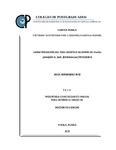Caracterización del pool genético silvestre de Vanilla planifolia G Jack (Orchidaceae) en Oaxaca
Abstract
Los especímenes silvestres de V. planifolia forman parte del acervo genético primario y son de suma importancia para la conservación de la especie. Sin embargo, la información existente sobre poblaciones silvestres, las cuales en México se distribuyen principalmente en el estado de Oaxaca, es nula. El objetivo de la presente investigación fue conocer la distribución potencial y la variación morfológica, fitoquímica y genética que integra el acervo genético silvestre de V. planifolia en el estado de Oaxaca. La delimitación de zonas potenciales se determinó mediante el modelo de máxima entropía (Maxent), con 22 variables bioclimáticas como predictores. La variación morfológica se evaluó a través del labelo de la flor. La variación fitoquímica se determinó con variables que definen la calidad aromática del fruto (vainillina, ácido vaníllico, p-hidroxibenzaldehído, acido p-hidroxibenzoico) mediante un análisis de cromatografía líquida de alta resolución. La variación genética se evaluó con 14 loci microsatélites para calcular el grado de diferenciación genética entre las poblaciones. El hábitat potencial de V. planifolia se distribuyó en cuatro zonas del estado de Oaxaca. Las variables que determinan la distribución son: precipitación y régimen de humedad del suelo. La mayor cantidad de variabilidad genética fue encontrada entre individuos (55%) que conforman las poblaciones silvestres de V. planifolia, las cuales posen un 45 % de variabilidad genética entre ellas. La variación infraespecífica de las poblaciones silvestres de V. planifolia está determinada por dos genotipos (G1 y G2). El genotipo G1 expresa dos formas del labelo en condiciones del clima templado húmedo y dos aromas con concentraciones de la sumatoria de compuestos menores sobre el contenido de vainillina (∑CM/vainillina) de 8 a 11% y una de 13%. El genotipo G2 expresa dos formas del labelo, una que corresponde al clima templado húmedo del pacifico donde la expresión del aroma responde ∑CM/vainillina de 9% y la expresión del labelo que corresponde al clima trópico húmedo, donde el aroma tiene una concentraciones de ∑CM/vainillina de 12%. _______________ CHARACTERIZATION OF WILD GENE POOL OF Vanilla planifolia G. Jack. (ORCHIDACEAE) IN OAXACA. ABSTRACT: Wild specimens of V. planifolia are part of the primary gene pool and are important for the conservation of the species. However, there is a lack of information on the wild populations of vanilla, which in Mexico are mainly distributed in the state of Oaxaca. The objective of this research was to determine the potential distribution, and the morphological, phytochemical and genetic variation that integrates the wild gene pool of V. planifolia in the state of Oaxaca. The delineation of potential areas was carried out with the model of maximum entropy (Maxent), with 22 bioclimatic variables as predictors. Morphological variation was evaluated base on lip flower. Phytochemical variation was determined with variables defining aromatic fruit quality (vanillin, vanillic acid, p-hydroxybenzaldehyde, p-hydroxybenzoic), by analysis of high-performance liquid chromatography. The genetic variation was assessed using 14 microsatellite loci to estimate the degree of genetic differentiation between populations. Potential habitat of V. planifolia was distributed in four areas of the state of Oaxaca. The variables that determine the vanilla distribution were precipitation and soil moisture regime. Most genetic variability (55%) was found among individuals within wild populations of V. planifolia, while genetic variation between populations was 45%. The infraspecific variation of wild populations of V. planifolia is determined by two genotypes (G1 and G2). G1 genotype expresses two forms of the labellum in the humid temperate climate, two scents with concentrations of the sum of minor compounds on vanillin (ΣCM/vanillin) of 8 to 11%, and a scent with concentrations of 13%. Genotype G2 expresses two forms of the labellum of the flower; the first was associated with humid temperate climate of the Pacific, where the expression of flavor responds to ΣCM/vanillin 9%; the second expression of the labellum was associated with tropical humid climate, where the aroma had a concentration ΣCM/vanillin 12%.
Collections
- Tesis MC, MT, MP y DC [398]


